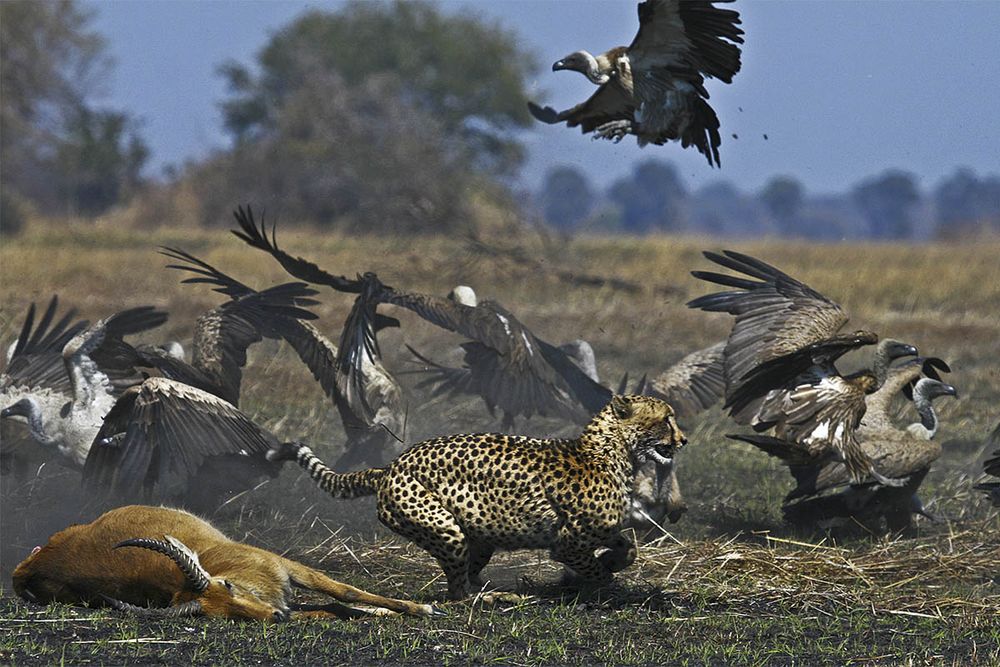Kafue is Zambia’s oldest park and by far the largest. It was proclaimed in 1950 and is spread over 22 400 square kilometres – the second largest national park in the world and about the size of Wales.
Despite the Park’s proximity to both Lusaka and the Copperbelt, it has remained underdeveloped until the most recent years. Despite the depravations of poaching and lack of management, the Park is still a raw and diverse slice of African wilderness with excellent game viewing, birdwatching and fishing opportunities.
From the astounding Busanga Plains in the North-western section of the Park to the tree-choked wilderness and the lush dambos of the south., fed by the emerald green Lunga, Lufupa and Kafue Rivers, the park sustains huge herds of a great diversity of wildlife. From the thousands of red lechwe on the Plains, the ubiquitous puku, the stately sable and roan antelopes in the woodland to the diminutive oribi and duiker. The solid-rumped defassa waterbuck, herds of tsessebe, hartebeest, zebra and buffalo make for a full menu of antelope.
Large prides of lion, solitary leopards and cheetahs are the prime predators. There is a host of smaller carnivores from the side-striped jackal, civet, genet and various mongoose.
Birdwatching – especially on the rivers and the dambos is superb. Notables include the wattled crane, purple crested loerie and Pel’s fishing owl. Over 400 species of birds have been recorded throughout the park.
The Kafue and Lunga Rivers offer superb fishing opportunities, especially good bream, barbel and fresh water pike. Most lodges have fishing tackle, rods, boats and bait available. Musungwa Lodge in the south, hosts an annual fishing competition in September on Lake Itezhi Tezhi.
What to See
Spread over such a vast area, the Kafue National Park encompasses a variety of landscapes.
The spectacular Busanga Plains in the north is a vast flat expanse that stretches in all directions as far as the eye can see – one of Zambia’s most significant wetland resources and one of the few untouched by development or human activity. This vast watery wilderness, flooded in the wet season by several rivers and streams covers an enormous 750 square kilometres. It drains into the Lufupa River, a tributary of the Kafue River. The floods reach their height from March to May, after the rains and large herds of hippo are stranded in the shallow pools left as the water recedes in the dry season.
The lush grasslands are grazed by red lechwe in their thousands. Fifty years ago, lechwe were almost extinct in this area. The establishment of the national park has seen a phenomenal recovery in their numbers and it is a sight of great beauty to see them wandering in such vast herds across the golden plains. During the wet season they splash about in the shallow waters, and, interestingly enough, lion, who usually dislike water, can be seen chasing them through water at least a half a meter deep.
Other antelope found here are blue wildebeest, Lichtenstein’s hartebeest, (frequently seen) buffalo, zebra, reedbuck, oribi, puku and impala (frequently seen) . Bushpig and warthog are also inhabitants of the plains. The shy swamp-dwelling sitatunga is found here, its widespread hooves enabling it to walk on the floating reedmats.Roan antelope are seen regularly in the northern sector as well as big herds of sable 30-40 strong.
The wealth of game on the plains are a big attraction for lions and prides of up to twenty are spotted regularly. Cheetah and Leopard also roam the plains, the cheetah being able to exercise their famous turn of speed, reaching up to 125 kilometres an hour. They are often seen on the plains.
QUote from one of the Game Guides in Kafue:
“We have been having some incredible sightings over the last few weeks: a brand new wildebeest calf trying to gain its feet for the first time, going straight for the nipple and then being blown over by the wind; mating lions with all the grimacing, lip curling, teeth baring, ear biting and to round it off, strange noises; a pair of cheetah on a termite mound, completely relaxed and then ten of the hugest crocodiles resting their ugly snouts on a Kudu bull one of them must have pulled into the water – a truly sobering sight!”
The Itezhi Tezhi dam ….
In the south the Kafue runs into the Itezhi Tezhi Dam covering an area of 370 square kilometres. This vast inland sea is surrounded in parts by grassy plains, often ‘mowed’ by hippos. Rocky bays and stretches of submerged trees provide perfect perches for the many waterbirds inhabiting the area – fish eagles, cormorants, spoonbills and the stately goliath Heron. Elephant. buffalo, zebra and wildebeest frequent the dam. Itezhi is also an angling paradise and home to an annual fishing competition.
The waters of the Kafue River are home to large numbers of hippopotamus, crocodiles and water monitors.
Other species found in the Park include the rare and secretive yellow-backed duiker, common duiker, kudu, grysbok, warthog, bushpig, serval, hyena, jackal, baboon, vervet monkey, porcupine, civet, genet and many species of mongoose.
Unusual features are the knobbly termite mounds scattered across the plains. There are teak forests, large numbers of the striking ‘candelabra’ tree, and many large black boulders often looking deceptively like a herd of elephant. Much of the park is covered by ‘Miombo’ Woodland opening out into large grassy dambos. Hartebeest, wildebeest, buffalo and zebra are often found frequenting these areas.
